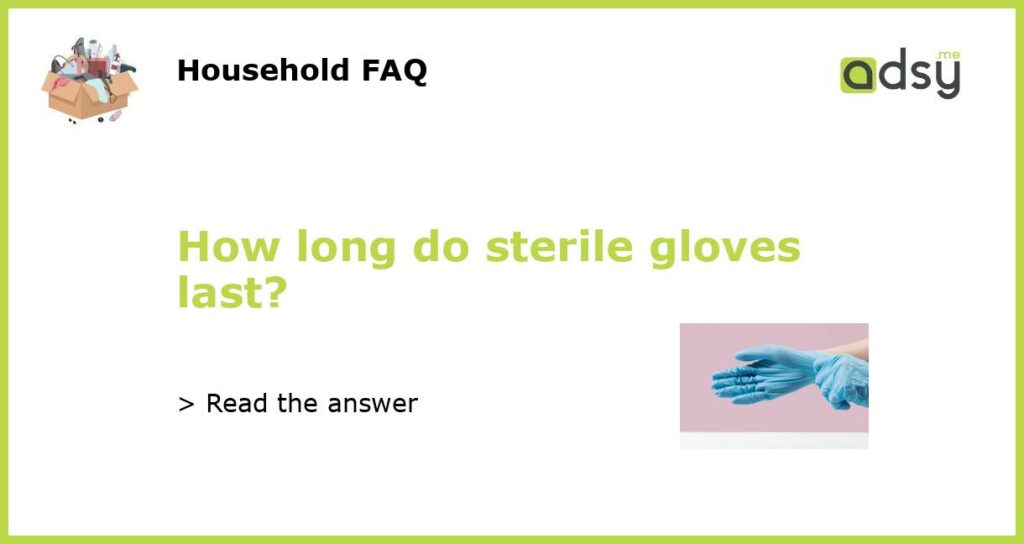Why is the lifespan of sterile gloves important?
The lifespan of sterile gloves is an important factor in maintaining the safety and effectiveness of medical procedures. Sterile gloves are used to protect both healthcare workers and patients from the transmission of infectious diseases, as well as to prevent contamination of sterile fields during surgery or other invasive procedures.
It is crucial to understand the factors that can affect the lifespan of sterile gloves in order to ensure their reliability and effectiveness. From storage conditions to material degradation, several factors can impact the integrity of these gloves over time.
What is the typical lifespan of sterile gloves?
The typical lifespan of sterile gloves can vary depending on several factors, including the type of material and the specific use case. However, in general, sterile gloves are designed to be used for a single patient encounter or procedure.
During a procedure, sterile gloves may become compromised or contaminated, making it necessary to discard them and use a new pair. This is especially important in cases where there is a high risk of contact with bodily fluids or infectious materials.
Factors that may affect the lifespan of sterile gloves
Several factors can impact the lifespan of sterile gloves and their overall effectiveness. It is important for healthcare professionals to be aware of these factors in order to ensure the safety of both themselves and their patients.
Some of the factors that can affect the lifespan of sterile gloves include:
- Material: Different materials may have varying levels of durability and resistance to tearing or puncture. Some materials may degrade more quickly than others, reducing the lifespan of the gloves.
- Storage conditions: Improper storage conditions, such as exposure to heat or humidity, can lead to the degradation of the gloves over time. It is important to store sterile gloves in a cool, dry place to maintain their integrity.
- Frequency of use: The more frequently sterile gloves are used, the more likely they are to become compromised or contaminated. Gloves that are used more frequently may need to be replaced more often to ensure their effectiveness.
- Type of procedure: Different procedures may pose different levels of risk for contamination or glove failure. Procedures that involve high-risk activities, such as surgery or handling infectious materials, may require more frequent glove changes.
Tips for ensuring the effectiveness of sterile gloves
To ensure the effectiveness of sterile gloves and minimize the risk of contamination or glove failure, it is important to follow best practices for their use and storage.
Some tips for ensuring the effectiveness of sterile gloves include:
- Proper hand hygiene: Before putting on sterile gloves, it is important to thoroughly wash and dry your hands to minimize the risk of introducing contaminants.
- Inspect gloves before use: Before using sterile gloves, carefully inspect them for any signs of damage or compromise. If any defects are found, discard the gloves and use a new pair.
- Follow proper donning and doffing techniques: Improper donning or doffing of gloves can increase the risk of contamination. Make sure to follow proper techniques for putting on and removing gloves to minimize the risk.
- Store gloves properly: Proper storage conditions can help maintain the integrity of sterile gloves. Store gloves in a cool, dry place away from direct sunlight or heat sources.
- Dispose of gloves after use: After a procedure, gloves should be carefully removed and disposed of in an appropriate manner. Do not reuse gloves, as this can increase the risk of contamination.
In conclusion
The lifespan of sterile gloves is an important consideration in maintaining the safety and effectiveness of medical procedures. While the typical lifespan of sterile gloves is for a single patient encounter or procedure, several factors can impact their overall effectiveness.
It is important for healthcare professionals to be aware of these factors and follow best practices for the use and storage of sterile gloves. By doing so, they can help ensure the safety of both themselves and their patients.






